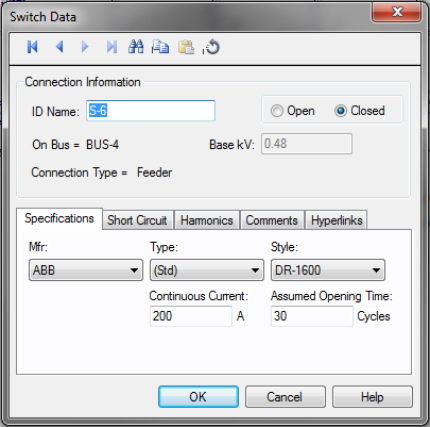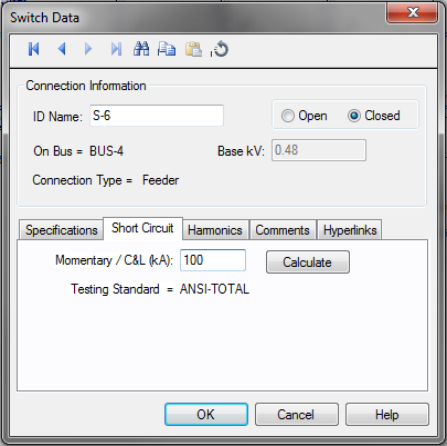

Figure 1: Switch Data Dialog Box
ID Name: Uniquely identifies the switch. This ID name is sometimes referred to as the switch name, and can be up to 12 characters long. The names default to SW-1, SW-2, SW-3, and so on as you enter new switches on the one-line diagram, but you can change those names if needed.
On Bus: The bus to which the switch connects, which must already exist on the one-line. For reference, the On Bus base kV is displayed next to the bus name.
Connection Type: Whether the switch is connected as a Feeder (such as to a cable, busway, or transformer) or as a Tie (between two buses).
Open/Closed: Normal state of the switch. If Open, the one-line displays "OPEN" next to the switch symbol. If Closed, the one-line symbol does not show the "OPEN" tag.
Mfr: Provides a list of switch manufacturers available in the device library. If the desired manufacturer is missing from the list, select Other.
Type: Switch types available from the manufacturer chosen in the Mfr field above. If the desired manufacturer is missing from the list, select Other.
Style: Switch styles available from the manufacturer chosen in the Mfr field above in the type specified. After you choose a manufacturer and type, the styles available in the yellow column of the corresponding device library page are displayed here.
Continuous Current: Continuous current of the switch. This value is for reference only and does not affect analysis.

Figure 2: Short Circuit tab of Switch Data Dialog Box
Mon/C&L (kA): Momentary or close & latch rating of the switch. The values available from the device library are typically the close and latch values for spring and mechanically operated switches, since this is the lowest rating. Some switches, however, have only momentary ratings.
Calculate: Fills in a computed value for the Mon/C&L field, based on the device library entry for Mfr, Type, Style, and the base kV. You can override this value by typing in a different number. This button also causes the appropriate Testing Standard to be displayed for your information. (The Testing Standard comes directly from the device library and cannot be changed.)
EasyPower can monitor whether or not the IEEE 519 guideline for harmonics is met at the point of common coupling.
Monitor IEEE 519 Point of Common Coupling: If selected, then the Harmonics Report indicates when this guideline is not being met.
kVA Demand: The kVA Demand.
PCC Isc/Load: The ratio of short circuit current to load current at the point of common coupling.
This tab is read-only and appears only if you have imported data from an SKM Data Format file. See Importing an SKM Format File for more information.
See Comments for information.
See Hyperlinks for information.
| Database Technical Reference |